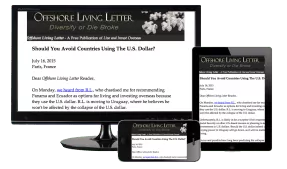
Insider Tips For Managing Overseas Rentals
Renting out a property that you also use can be complicated. The Paris 2024 Olympics reminded me of this.
A friend in Paris swapped apartments with someone they know. They wanted to be out of the city during the games, while their friend wanted to be in the thick of things. He’s an Olympic-holic who has attended the games for the last 20 years.
Letting someone you know stay in your apartment for a couple weeks is different than renting to strangers.
Someone I know who lives in Japan was planning on renting their apartment in Tokyo at an inflated rate during the 2020 Olympics. That didn’t work out because the Olympics were postponed…
But a couple weeks of rental income, albeit at inflated rates, didn’t seem worthwhile to me considering the risks of renting your personal home to a stranger.
Even the best-intentioned guest could break an appliance they aren’t familiar with. A bad guest may stain your towels, scratch your counters, or leave water rings on your wooden table.
A bad renter could be worse… like someone who decides they like some of your knickknacks or books enough to pack them in their suitcase when they leave.
Of course, someone who already has a rental property in Paris will have done well this summer and wouldn’t have had to worry about damage to personal items… assuming their rental was more for investment than personal use.
Go Offshore Today
Sign up to our free twice a week dispatch Offshore Living Letter
and immediately receive our FREE research report
on how to live tax-free today, while earning up to $215,200!
Managing the personal versus the investment for a second home purchase can be tricky. You want it to be comfortable enough for you when you’re there, but you don’t want it to have too many personal items or furniture and decorations that you really care about.
And, if you consider your property purchase on a scale, with the far-left side being for pure investment and the far-right side being for 100% personal use, the farther to the right you are on the scale, the less likely you are to get a great yield on the rental side.
Simply stated, overspending on furnishings can kill your returns.
Two examples I like to use are leather couches and expensive artwork when warning investors about spending too much on renovating and furnishing.
While you may want both of those things in your apartment for your own enjoyment when you’re staying there, you’re not going to get a return on that extra capital expense.
Spending $5,000 instead of $1,500 for a sofa may not seem like a big deal when you’re furnishing a place. However, overspending doesn’t usually stop with just one item.
More importantly, that extra $3,500 means you need to charge an extra $10 to $15 a night to recoup your $3,500 and get a decent yield on your couch investment.
Maybe you can charge that much more per night because you have a nice couch… but probably not, unless your property is targeting the upper end of the rental market. If that’s the case, then you’ll be working with a different budget.
On the far left of the scale, it’s possible that a $250 Ikea futon is all your apartment needs, but that’s not likely to be something you want to sleep on when using the property.
Go Offshore Today
Sign up to our free twice a week dispatch Offshore Living Letter
and immediately receive our FREE research report
on how to live tax-free today, while earning up to $215,200!
The other consideration for the leather sofa is what you’ll do when someone stains or damages it. To keep your rental property looking good, you’ll need to repair or replace it, depending on the extent of the damage… so that’s another potential drag on your yields.
Smaller items will get lost or broken. For some reason, most of the world has trouble with spoons. They go missing more than any other cutlery item. Plates and glasses get broken as well.
Buying a set of dishes that has a great design that you like is fine. The cost may not be any more than other available options…
But what do you do when your set of eight plates and bowls dwindles to five dinner plates, six bowls, and seven salad plates? Your great design probably won’t be available anymore, so you’ll have to repla
ce everything with a new set.
Simple white plates and bowls from a store where you can buy individual items that they always have in stock is the better way to go.
Even if you can’t find the exact same plates as replacements, you should be able to find something similar enough in white.
Same thing for cutlery. Buy from a store where you can buy individual pieces… or buy an extra set that you keep in storage, so that you have replacements that match.
If you’re renting out your property when you’re not using it to help cover carrying costs and you’re not worried about the highest possible return on your investment, you’re moving towards the middle of the scale.
In that case, you can buy what you like if you remember that it will impact your returns.
You should also consider the time of year when you wish to use the property. Many investors who like the idea of having a vacation pad that can pay them a nice rental yield end up using the apartment during the high season.
The high season in Panama is January through March. That’s the dry season in Panama and also when it’s cold up north.
The highest volume of visitors to Panama comes in those months… snowbirds and vacationers. The rest of the year, you can get renters, but in the high season, you can expect 100% occupancy if you’re in the right location.
Use your own apartment for these three months, and you’ll decimate your rental returns, potentially cutting them in half or more.
You must ask yourself if that’s what you’re really looking for in an investment property… or maybe change your personal plans to spend April through June in Panama, when you won’t be cutting into your rental income as much.
Portugal has a similar high-season situation, although the months are different—mid-April to mid-September.
I know an investor looking to buy a property in the Algarve to use for part of the year. This investor wants to escape Canadian winters, so they’ll use the apartment from November to February or March.
That schedule works perfectly for that market and will have limited impact on rental returns. However, if they overfurnish because they want to use the apartment themselves, that will impact their returns.
Balancing where you end up on the scale between investment and personal use can be tricky. If you’re aware of what you’re doing and manage your expectations, you’ll be fine.
Stay diversified,
Lief Simon
Director, Offshore Living Letter




